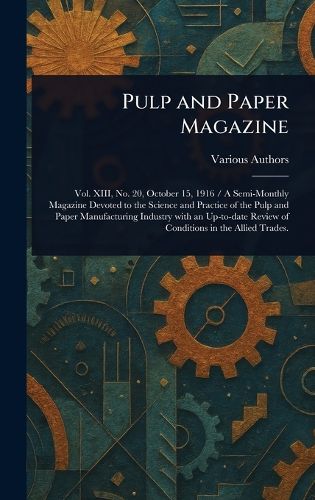Readings Newsletter
Become a Readings Member to make your shopping experience even easier.
Sign in or sign up for free!
You’re not far away from qualifying for FREE standard shipping within Australia
You’ve qualified for FREE standard shipping within Australia
The cart is loading…






This title is printed to order. This book may have been self-published. If so, we cannot guarantee the quality of the content. In the main most books will have gone through the editing process however some may not. We therefore suggest that you be aware of this before ordering this book. If in doubt check either the author or publisher’s details as we are unable to accept any returns unless they are faulty. Please contact us if you have any questions.
Explore the historical landscape of the wood-pulp industry with "Pulp and Paper Magazine, Vol. 13, No. 20, October 15, 1916." This meticulously prepared print edition offers a fascinating glimpse into the science and practice of pulp and paper manufacturing during the early 20th century.
A semi-monthly periodical featuring various authors, this volume provides an up-to-date review of conditions in the allied trades, making it an invaluable resource for those interested in industrial engineering, energy, and manufacturing. Delve into the intricacies of the wood-pulp industry through detailed articles and insights.
This volume captures a pivotal moment in the evolution of a vital industry. A unique window into the technological and economic factors shaping the production of pulp and paper, this magazine is a must-have for historians, engineers, and anyone curious about the roots of modern manufacturing.
This work has been selected by scholars as being culturally important, and is part of the knowledge base of civilization as we know it.
This work is in the public domain in the United States of America, and possibly other nations. Within the United States, you may freely copy and distribute this work, as no entity (individual or corporate) has a copyright on the body of the work.
Scholars believe, and we concur, that this work is important enough to be preserved, reproduced, and made generally available to the public. We appreciate your support of the preservation process, and thank you for being an important part of keeping this knowledge alive and relevant.
$9.00 standard shipping within Australia
FREE standard shipping within Australia for orders over $100.00
Express & International shipping calculated at checkout
This title is printed to order. This book may have been self-published. If so, we cannot guarantee the quality of the content. In the main most books will have gone through the editing process however some may not. We therefore suggest that you be aware of this before ordering this book. If in doubt check either the author or publisher’s details as we are unable to accept any returns unless they are faulty. Please contact us if you have any questions.
Explore the historical landscape of the wood-pulp industry with "Pulp and Paper Magazine, Vol. 13, No. 20, October 15, 1916." This meticulously prepared print edition offers a fascinating glimpse into the science and practice of pulp and paper manufacturing during the early 20th century.
A semi-monthly periodical featuring various authors, this volume provides an up-to-date review of conditions in the allied trades, making it an invaluable resource for those interested in industrial engineering, energy, and manufacturing. Delve into the intricacies of the wood-pulp industry through detailed articles and insights.
This volume captures a pivotal moment in the evolution of a vital industry. A unique window into the technological and economic factors shaping the production of pulp and paper, this magazine is a must-have for historians, engineers, and anyone curious about the roots of modern manufacturing.
This work has been selected by scholars as being culturally important, and is part of the knowledge base of civilization as we know it.
This work is in the public domain in the United States of America, and possibly other nations. Within the United States, you may freely copy and distribute this work, as no entity (individual or corporate) has a copyright on the body of the work.
Scholars believe, and we concur, that this work is important enough to be preserved, reproduced, and made generally available to the public. We appreciate your support of the preservation process, and thank you for being an important part of keeping this knowledge alive and relevant.